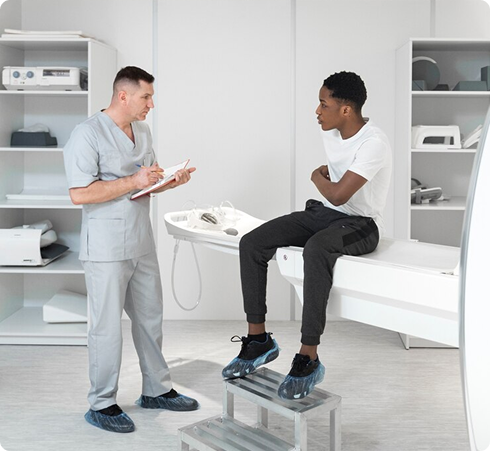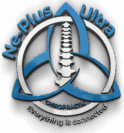Brief Description and Symptoms
Knee pain is one of the most common musculoskeletal complaints affecting people of all ages and activity levels. As the largest joint in the body, the knee bears significant weight and stress during daily activities and is vulnerable to a wide range of injuries and degenerative conditions.Knee problems can significantly impact mobility, independence, and quality of life.
At Ne-Plus Ultra Chiropractic in Pasadena, California, Dr. Lamar Baddley offers comprehensive, non-surgical approaches to knee pain that address the symptoms and the underlying biomechanical factors contributing to knee dysfunction. With his expertise in joint mechanics and rehabilitation, Dr. Baddley provides personalized care that helps patients regain comfort, mobility, and function.

Understanding
Common Types of Knee Pain
Osteoarthritis
-
Degenerative joint disease involving breakdown of cartilage
-
Typically develops gradually over time
-
More common in older adults and those with previous knee injuries
-
Often creates pain, stiffness, and reduced range of motion
Ligament Injuries
-
Sprains or tears of the major knee ligaments (ACL, MCL, LCL, PCL)
-
Usually result from trauma, sports injuries, or sudden directional changes
-
Can create instability and significant functional limitations
-
Often accompanied by swelling and restricted movement
Patellofemoral Pain Syndrome
-
Pain around or behind the kneecap (patella)
-
Often called "runner's knee" or "jumper's knee"
-
Related to improper tracking of the patella
-
Common in athletes and active individuals
Tendinitis/Tendinosis
-
Inflammation or degeneration of tendons around the knee
-
Common in the patellar tendon (jumper's knee) or quadriceps tendon
-
Often related to overuse or repetitive stress
-
Creates pain that typically worsens with activity
Meniscus Injuries
-
Damage to the cartilage pads (menisci) that cushion the knee joint
-
Can occur from traumatic injuries or degenerative processes
-
May cause catching, locking, or giving way sensations
-
Often creates localized pain and swelling
Iliotibial Band Syndrome
-
Irritation of the iliotibial band as it crosses the lateral knee
-
Common in runners, cyclists, and hikers
-
Related to repet itive friction and biomechanical issues
-
Causes pain on the outer side of the knee
Bursitis
-
Inflammation of the fluid - filled sacs (bursae) that cushion the knee
-
Often affects the prepatellar bursa (housemaid's knee) or pes anserine bursa
-
May result from direct pressure, overuse, or inflammatory conditions
-
Creates localized swelling and pain

Common Symptoms
- Pain that may be sharp, dull, aching, or burning
- Swelling or inflammation around the knee joint
- Stiffness, especially after sitting or in the morning
- Reduced range of motion
- Difficulty bearing weight on the affected leg
- Instability or "giving way" sensations
- Locking or catching of the knee during movement
- Clicking, popping, or grinding sounds
- Weakness in the knee or surrounding muscles
- Pain that worsens with activity or at rest (depending on the condition)
- Visible deformity or misalignment (in some cases)
- Warmth or redness around the joint (in inflammatory conditions)
How Chiropractic Care
Addresses Knee Pain
At Ne-Plus Ultra Chiropractic, Dr. Baddley takes a comprehensive approach to knee pain that addresses the knee joint and biomechanical relationships with the foot, ankle, hip, and spine. This holistic perspective allows for a more complete and lasting resolution of knee problems.
Comprehensive Assessment
A thorough evaluation is essential for effective treatment of knee pain. Dr. Baddley’s assessment
includes:
-
Detailed health history and pain pattern analysis
-
Comprehensive physical examination of the knee and related structures
-
Range of motion and strength testing
-
Orthopedic tests specific to knee conditions
-
Assessment of gait and movement patterns
-
Evaluation of foot, ankle, hip, and spine mechanics
-
Postural analysis
-
Functional movement screening
-
Review of any existing imaging studies
This multifaceted assessment allows Dr. Baddley to identify:
-
Biomechanical factors contributing to knee dysfunction
-
Movement pattern abnormalities
-
Muscle imbalances or weakness
-
Joint restrictions or instabilities
-
Related issues in the kinetic chain that affect knee function
-
Underlying factors that may have contributed to the condition
Personalized Treatment Approaches
Joint Adjustments and Mobilization
Gentle, specific techniques to restore proper alignment and movement:
-
Knee joint adjustments to improve tracking and biomechanics
-
Patellofemoral mobilization for proper kneecap movem ent
-
Tibiofemoral joint techniques to enhance function
-
Ankle and foot adjustments to improve lower extremity mechanics
-
Hip and pelvic adjustments to address related biomechanical issues
-
Lumbar spine adjustments when spinal factors contribute to knee pain
Kinesio Taping
Application of specialized elastic tape to:
-
Provide support without restricting movement
-
Improve patellar tracking
-
Reduce pain and inflammation
-
Enhance proprioceptive awareness
-
Facilitate proper muscle activation patterns
Soft Tissue Therapy
Targeted techniques to address muscle and connective tissue issues:
-
Myofascial release for tight muscles around the knee
-
Cross-friction massage for tendon healing
-
Trigger point therapy for pain reduction
-
Instrument - assisted soft tissue mobilization
-
Release of iliotibial band and related structures
-
Techniques to improve circulation and reduce inflammation
Modalities and Physical Therapi es
Complementary treatments to enhance healing:
-
Cold laser therapy to reduce inflammation and promote tissue repair
-
Ultrasound for deep tissue healing
-
Electrical stimulation for pain management and muscle re-education
-
Contrast therapy (alternating heat and cold)
-
Compression therapies to reduce swelling
Therapeutic Exercise Rehabilitation
Progressive exercise programs designed to:
-
Strengthen muscles supporting the knee (quadriceps, hamstrings, calves)
-
Improve flexibility in key muscle groups
-
Enhance stability and proprioception
-
Correct movement patterns that stress the knee
-
Restore functional movement capacity
-
Prevent recurrence of knee problems
Orthotics and Support
When appropriate, recommendations for:
-
Custom or pre - fabricated foot orthotics to improve lower extremity alignment
-
Knee braces or supports for specific conditions
-
Proper footwear selection for optimal knee mechanics
-
Assistive devices during the recovery process
Lifestyle and Activity Modifications
Practical guidance on:
-
Activity modification to reduce knee stress
-
Proper techniques for daily activities
-
Ergonomic recommendations
-
Weight management strategies when appropriate
-
Progressive return to sports and recreational activities
Evidence-Based Approach
Our treatment protocols are based on current research and clinical guidelines for knee pain management. Studies published in Journals such as the Journal of Manipulative and Physiological Therapeutics and the Journal of the American Osteopathic Association have demonstrated the effectiveness of multimodal chiropractic approaches for various knee conditions, showing improvements in pain levels, function, and quality of life.

Expected Outcomes and
Benefits of Treatment
Patients who receive chiropractic care for back pain at Ne-Plus Ultra Chiropractic typically experience a range of positive outcomes:
Short-Term Benefits
-
Pain Reduction
Significant decrease in knee pain intensity
-
Decreased Inflammation
Reduction in swelling and irritation
-
Improved Mobility
Increased range of motion in the knee joint
-
Better Function
Enhanced ability to perform daily activities
-
Reduced Medication Need
Less reliance on pain medications
Functional Improvements
-
Corrected Biomechanics
improved alignment and movement patterns
-
Enhanced Joint Health
Better nutrition and function of joint structures
-
Stronger Supporting Muscles
Improved stability and support
-
Preventive Strategies
Tools and knowledge to prevent recurrence
-
Delayed Progression
Slowed advancement of degenerative conditions
Quality of Life Improvements
-
Walking Comfort
Improved gait and reduced pain with walking
-
Stair Navigation
Better ability to ascend and descend stairs
-
Recreational Activities
Return to sports and hobbies
-
Work Performance
Enhanced comfort and capability with occupational tasks
-
Independence
Maintained or improved self - sufficiency in daily living
Don’t let knee pain limit your mobility and quality of life. At Ne-Plus Ultra Chiropractic, Dr. Lamar Baddley offers Specialized care that addresses the root causes of your knee pain, not just the symptoms. Our comprehensive approach combines advanced chiropractic techniques with therapeutic exercises, lifestyle guidance, and preventive strategies to help you achieve lasting relief and improved function.
Whether you’re dealing with a recent knee injury, chronic pain, or degenerative conditions like osteoarthritis, we’re here to help you find relief and restore your active lifestyle. Our treatment
Plans are tailored to your specific condition, circumstances, and goals, ensuring the most effective path to recovery.
Take the first step toward knee pain relief today.**
Your journey to better mobility and comfort starts here.

Evidence-Based Approach
We understand that dealing with insurance claims and legal documentation can be stressfulafter an accident. Our office staff is experienced in handling personal injury cases and can assistwith
-
Detailed documentation of injuries and treatment for insurance claims
-
Communication with insurance adjusters and attorneys when needed
-
Clear explanation of coverage and benefits
-
Assistance with paperwork and filing requirements
Clinic Locations
House calls by appointment
- South Pasadena, CA
- San Marino CA
- Altadena CA
- Alhambra CA
- San Gabriel CA
- La Canada Flintridge, CA
- Sierra Madre CA
- Temple City, CA
- Monterey Park, CA
- Rosemead, CA
- Arcadia CA
- Glendale, CA
- Monrovia CA
- El Monte CA
- South El Monte CA
